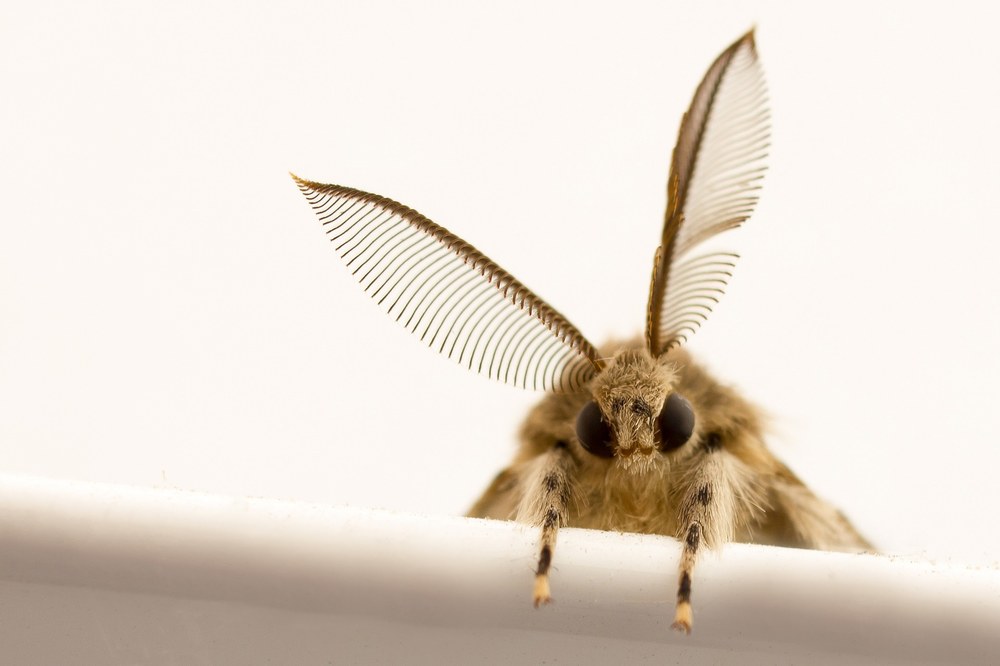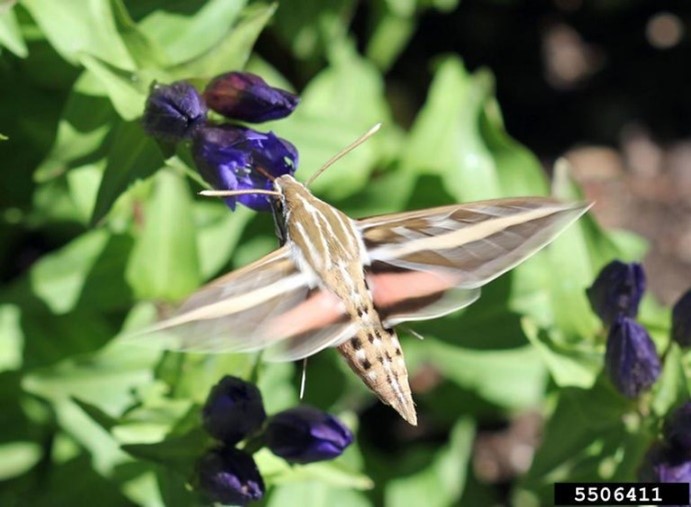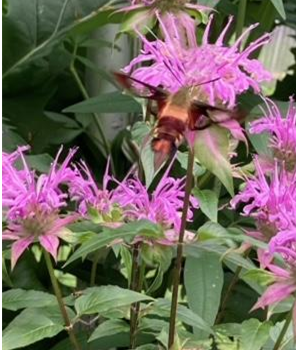Posted: May 15, 2023
The best-known pollinators are bees and butterflies, but there are other pollinators that don't get enough credit for their assistance with pollination. Moths, in particular, are not only forgotten pollinators, but they are also a critical part of the food web. Unfortunately, moth species are in serious decline due to habitat loss and pesticide use. Learn how we can all help support this beneficial insect with our gardens and landscapes.

What is a pollinator? According to the National Park Service, a pollinator is anything that helps carry pollen from the male part of the flower to the female part of the same or another flower. This must occur for some plants to become fertilized and produce fruits, seeds, and young plants. This can occur in several ways. Some plants are self-pollinating, others may be fertilized by pollen carried by the wind or water, and others are pollinated by insects and other animals.
The best-known pollinators are bees and butterflies, but there are other pollinators that don't get enough credit for their assistance with pollination. Moths, in particular, are the forgotten pollinators. Moths have been around for approximately 190 million years and there are almost 170,000 species of moth. Butterflies have only been around for 56 million years and there are about 17,500 species of butterflies. Moths are in the insect order Lepidoptera, and they share this order with butterflies. Here are the differences between butterflies and moths:
| Butterflies | Moths |
|---|---|
| Usually diurnal-active during the day | Usually nocturnal or crepuscular, some active during the day, some active day and night |
| Rest with wings folded together | Often rest with wings folded flat, or tent-like over their bodies to hide their abdomen |
| Often with colorful patterns on top of wings but with dull or camouflaged patterns on the undersides of wings | Often dull or camouflaged colors and patterns |
| Often with slender, filamentous antennae, possibly clubbed or hooked at ends | Antennae may be threadlike or feather-like (males usually have larger antennae) |
| Bodies and legs are long and thin | Bodies and legs are short and plump |
| Pupate in chrysalis* | Pupate in cocoon* |
*Often the terms chrysalis and cocoon are used interchangeably, but they are two quite different things.
Chrysalis is specific to butterflies. It is the result of a butterfly larva (caterpillars) shedding its exoskeleton (molting) for the final time to become a pupa, the stage of life where it transforms into the adult butterfly.
Cocoons are formed by moth larvae spinning silk around themselves to create a protective and warm casing in which they molt into the adult moth.
Moths are a critical part of the food web. Moths and their larvae are food sources for many birds, owls, bats, frogs, toads, and lizards. Adults emerge from their winter cocoons in spring to mate. A female moth can drop more than 1,000 eggs. By summer, those eggs become caterpillars, but only 1% of these caterpillars survive to adulthood.
Pollinators are essential to our environment because approximately 75% of all flowering plants rely on animal-assisted pollination to reproduce. They also play a significant role in both our economy and diet as one out of every three bites of food we eat exists because of pollinators. Moths tend to prefer pale and light-colored flowers because these blossoms reflect moonlight much better and are easier for moths to find in the dark. This is the main reason that we should try to provide a pollinator-friendly environment. The easiest way to do so is to use native plants in your landscape. Moths are linked to native plants and these plants are key for moth survival. Moths seek nectar from various native plants, like milkweeds, mountain mint, and bee balm. As the moths drink the nectar, they carry pollen dust from bloom to bloom and thereby help plants make seed and reproduce.
The moth life cycle consists of four stages: egg, larva, pupa (cocoon), and adult. Adult moths lay eggs on or near the preferred native plant for the larval stage. Grasses, flowers, shrubs, or trees are essential egg laying locations for moths. The caterpillar stage feeds on this host plant before forming a pupa and becoming an adult. Moths need a habitat that provides flowering plants, nesting sites, and shelter. This habitat is found in gardens, meadows, forest edges, hedgerows, and woodlands. They also need nesting sites as well as protection from severe weather and predators. Shelter areas can include layers of vegetation, leaf litter, dead and dying trees, rock crevices, tunnels in wood, plant stems, or underground.
Here are a few examples of moth species that may be pollinating the plants in your landscape or gardens.

White-lined Sphinx Moth (Hyles lineata)
This sphinx moth is an incredible North American pollinator. These moths are primarily nocturnal fliers but are visual during the day too. They are attracted to scented flowers and during the day will flock to brightly colored ones, but at night they prefer white or pale-colored flowers. They like cardinal flowers, columbine, evening primrose, honeysuckle, lilac, penstemon, and phlox. The wingspan of this moth is up to three inches, making it one of the bigger North American moths.

Snowberry Clearwing Moth (Hemaris diffinis)
This moth is easily confused with a bumble bee and is a native of the eastern United States and Canada. It has clear wings, which is unusual among Lepidoptera. This diurnal (active during daytime) moth visits a variety of flowers like blue star, honeysuckle, and snowberry. The adults mimic bumble bees. All stages of this moth provide food for predators.

Hummingbird Clearwing Moth (Hemaris thysbe)
This moth resembles a miniature hummingbird as it hovers in the air over flowers, using its long tongue to probe for nectar. Although they are diurnal (active during the daytime), they are most frequently noticed at dusk and dawn. The adult moths take nectar from a wide range of flowers, particularly ones with long floral tubes, such as honeysuckles, bee balms, clovers, phlox, thistles, and vetches.
In addition to bees, butterflies, and moths, there are also other pollinators, like wasps, flies, beetles, birds, small mammals, and bats that need our help due to various threats to their populations. One of the main threats to moth populations is habitat loss and fragmentation. This makes it difficult for moths and other pollinators to find food and nesting sites necessary for their survival. The loss of native plants in their habitat has had a significant impact on moth populations worldwide. Another threat to moths is the widespread use of insecticides and pesticides. They contain neonicotinoid, a common ingredient that remains in the plant's tissues, pollen, and nectar and are lethal when consumed by moths and other pollinators. Herbicides, widely used for weed control, also contribute to decreased insect populations by destroying important forage plants or nesting habitat. Non-native plants or animals can increase competition for resources among the moths and other pollinators since native plants are necessary for moths to survive. While some non-native plants can provide pollen used by insects, non-native and invasive plants out-compete native plants for space, crowding out important native host plants that moths and other beneficial insects so desperately need.
Climate change is disrupting the relationship between pollinators and plants. Warmer temperatures affect the timing and location of flowering plants which make them out of sync with the life cycles of the insect pollinators that depend on them. Moth populations are also declining due to drought and rain events, which can increase changes in overwintering conditions, thus reducing survival of all types of pollinators.
Light pollution is a threat to moths as they have evolved to fly at dusk or in darker conditions beneath moonlight and starlight and have great low-light vision. Too much light usually creates problems, as moths are attracted to lights, and they abandon their normal pollinating duties. As a result of these threats, there have been significant declines in moths and other insects worldwide.
Insects account for about 80% of the animal life on our planet. Because the number and diversity of insects are declining around the globe, we need to protect their habitats. While moths and other insects can seem like pests, they provide a wide range of services to plants and animals in our environment. Insects are critical to the survival of most life on Earth, including bats, birds, fish, and humans. Along with plants, moths and other insects are at the foundation of the food web. Most of the plants and animals we eat rely on insects for pollination or food. An example of this is 96% of songbirds feed insects to their young.
According to the U.S. Natural Resources Conservation Service, roughly 35% of the world's food crops depend on pollinators to reproduce and this includes moths. According to the U.S. Fish and Wildlife Service, more than 100,000 different animal species play roles in pollinating the 250,000 kinds of flowering plants on Earth, with insects like bees, wasps, moths, butterflies, flies, and beetles being the most common.
If the insect and moth populations continue to decline, there is the possibility that some food webs could collapse entirely. The dollar value of all the services that insects provide, would equal approximately $70 billion in the U.S. alone.
In Pennsylvania alone, there are over 350 species of moths. They help pollinate various flower species. To help protect all our pollinators, the volunteers of Penn State Extension Master Gardeners of Monroe County have created a habitat restoration demonstration garden, called Project NatureScape, that provides a welcoming habitat for bees, butterflies, moths, wasps, flies, and beetles. The garden features native plants that support various pollinators. It also features various garden beds that the average person can incorporate into their home landscapes. The mission statement of Project NatureScape is - "Learning from the past, taking action in the present, and protecting the future." This garden aims to teach the public understand the importance of providing all our pollinators a safe habitat so that they can continue to pollinate the plants that both humans and animals depend on.
The easiest way for all of us to help moths and other pollinators is to use our gardens and landscapes to increase pollinator habitat. Incorporating varieties of native plants with different blooming times from early spring to fall will help to provide food, shelter, and nesting sites. Some examples of native plants that help moths and other pollinators include mountain mint, bee balm, wild bergamot, Joe Pye weed, and thoroughwort. It is also recommended to leave your garden perennials standing over the winter and to resist the urge to clean up too many leaves in the fall. The seed heads attract songbirds and many beneficial insects over winter in standing stems and leaf litter.
So, let us not forget about moths. Together as a community, with each of our gardens and landscapes, by using native plants, decreasing pesticide use, and limiting outdoor artificial lighting, we can help them and all pollinator insects.
Article written by Lorena Koszarek, Penn State Master Gardener

